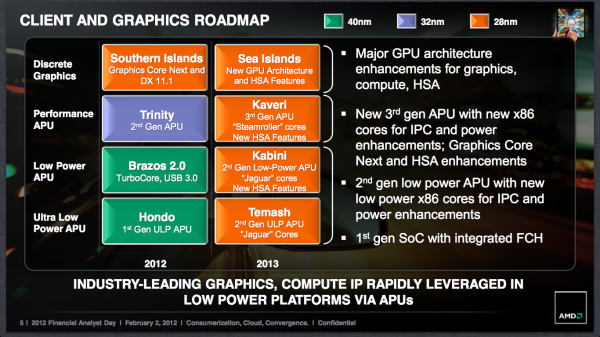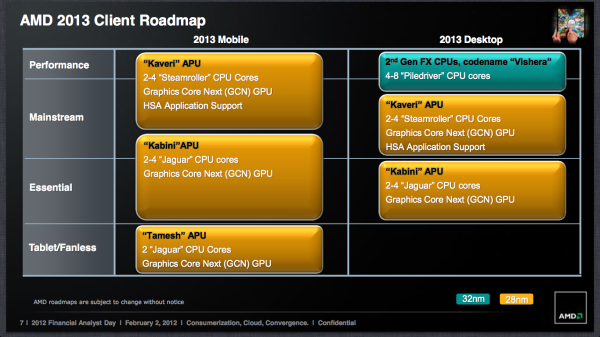Understanding AMD's Roadmap & New Direction
by Anand Lal Shimpi on February 2, 2012 6:16 PM EST- Posted in
- CPUs
- AMD
- Trade Shows
- AMD FAD 2012
We've been providing live coverage of AMD's 2012 Financial Analyst Day from Santa Clara today, but if you want a summary of the company's strategy under new CEO Rory Read you've come to the right place. Below you'll find links to everything we've published from AMD's FAD 2012:
AMD's Rory Read Outlines AMD's Future Strategy
AMD Outlines HSA Roadmap: Unified Memory for CPU/GPU in 2013, HSA GPUs in 2014
AMD is Open to Integrating 3rd Party IP in Future SoCs
AMD's Financial Analyst Day 2012 - Mark Papermaster, SVP & CTO Presentation
AMD: Flexible Around ISA
AMD Nods at Shorter Design Cycles, More Synthesized Designs
What AMD Views as Important: Tablets, Servers, Notebooks & GPUs
AMD & Compal Show Off 18mm Trinity Notebook
AMD's 2012 - 2013 Client CPU/GPU/APU Roadmap Revealed
AMD's 2012 - 2013 Server Roadmap: Abu Dhabi, Seoul & Delhi CPUs
AMD is Ambidextrous, Not Married to Any One Architecture, ARM in the Datacenter?
AMD's Tablet Architectures: Hondo at 4.5W, Future Sub-2W SoC
The name of the game for AMD in 2012 is execution. Far too often at previous AMD events we'd see a roadmap with no indication of whether or not AMD would actually stick to it. Plans were always aggressive and made sense, but execution rarely mirrored what was promised on paper. AMD in turn ended up delivering CPUs sometimes years after they were promised, which obviously didn't help grow the company.
Over the past few months Rory and his new management team at AMD have been restructuring the company to improve execution. As a much smaller company than Intel, AMD had an almost impossible task competing in the x86 space, but AMD should have also been far more agile than it was given its size. AMD's restructuring is supposed to fix these agility and execution problems. The proof will be in how well AMD is able to introduce products over the next 24 months.
As far as the roadmap goes, AMD already laid out what it hopes to accomplish by 2013. The best way to summarize AMD's next two years is: APUs and servers. On the APU side, we'll get updates to all of the current lines this year (Trinity & Brazos 2.0), but we'll also get a new 4.5W APU (Hondo) aimed at the Windows 8 tablet market. Now 4.5W is a bit high for a tablet but AMD has plans to bring even lower power architectures to market in the future. Next year we'll also see the first single-chip solutions from AMD: Kabini and Temash will integrate the I/O controller (SATA, USB ports, etc...) on-die. Intel is doing something similar with Haswell.
The big transition will happen next year, as AMD moves its entire APU stack from 32nm SOI to a bulk 28nm process at Global Foundries. This is an important move as it signifies the use of more easily synthesized designs, which enables AMD to bring out APUs in a quicker fashion and with lower design costs. Effectively everything follows the path laid by Brazos/Bobcat at this point. Note that AMD will be shipping 28nm APUs while Intel is well transitioned to 22nm, a gap that AMD has no intentions on narrowing. The process technology gap has almost always existed between AMD and Intel, but now AMD is taking a firm stance in saying that it has no intentions to blindly pursue the closing of that gap.
What once was a 3+ year design cycle for AMD CPUs and APUs now shrinks to less than 24 months (maybe even as short as 18 months) as a result of this migration to more easily synthesized designs. If this sounds a lot to you like the old GPU design cadence don't be surprised. AMD's APUs are, after all, largely made of GPU transistors that have always strayed from custom logic where possible. The big change is simply doing more non-custom x86 design.
Obviously AMD's ability to execute on this roadmap will depend heavily on Global Foundries delivering good yields at 28nm, however AMD does seem fairly confident at this point. That being said, 2013 is a very broad timeframe. Executing on the above roadmap sooner rather than later in 2013 will be the difference between a competitive AMD and one that's quickly written off.
I don't believe a move towards easily synthesized architectures is necessarily a bad thing. As long as AMD can deliver good performance at competitive prices the process technology really doesn't matter as much. Typically process technology was used as an enabler of good performance but as a newly fabless semiconductor, that strategy doesn't necessarily apply to AMD - at least not across all market segments. In other words, what works for Intel may not work for AMD.












84 Comments
View All Comments
A5 - Thursday, February 2, 2012 - link
The fact that their "enthusiast" desktop CPU will be 32nm through the end of 2013 essentially signals that they are giving up on that market.The Opteron 165 came out 6 years ago - the fact that that is the chip you have to point to is pretty telling, no?
Beenthere - Thursday, February 2, 2012 - link
Sorry but your beliefs are incorrect at this time.I don't have the Opteron 165. It was a reference to prior Opteron success for desktop use.
The point was that AMD is making faster Opterons that use AM3+ sockets. Why would they do this when they already have C32 and G34 sockets?
Look at the roadmap slide carefully with Piledriver, Steamroller and Excavator all bringing ~15% increase each year and fitting into AM3+ sockets. This ain't rocket science.
28 nm will not offer any big gains over 32nm so that's not even an issue. There is diminishing returns with each step to smaller traces. AMD has said they ain't going to push the trace size but instead they will optimise the cores for better performance.
http://www.anandtech.com/show/5488/amds-2012-2013-...
Impulses - Friday, February 3, 2012 - link
I'll never understand blind brand loyalty, specially for CPUs where there isn't much else to take into account besides performance per dollar... At least when it comes to other products the brand loyalists have additional arguments to stand on like build quality, support, reliability, etc.I've had one AMD system, an A64 3000+ Winchester, from the only brief period in history where they were on their game and able to out-execute and out-preform Intel. Every other desktop's been Intel based, they were almost always the smarter purchase. Altho if I was gonna replace my current netbook with another sub-$500 system I'd definitely opt for Brazos right now.
Shifting focus is a smart move for AMD, who cares if a few enthusiasts get butt hurt and a couple others keep hopelessly calling for high end parts? The mobile market's growing faster, it's already larger than the high end desktop market, and enthusiasts & halo products don't drive sales like they used to.
Plus, quite frankly, an Intel dominated mobile market is a heck of a lot scarier than an Intel dominated enthusiast market. Just look at what Intel's been pushing lately, ultrabooks are sexy but they're also a tool to drive the price of the average laptop up... Why do you think Atom hasn't seen a significant redesign by now? Except for Brazos, Intel has effectively been driving laptops upmarket while keeping Atom stagnant to prevent anyone else from eating into their profits.
If Intel dominates the enthusiast market a few of us might suffer a little, but not much because there's little incentive for Intel to suck a shrinking market dry. If Intel dominates mobile, EVERYONE loses.
IlllI - Friday, February 3, 2012 - link
all one has to do is take a look at ARM. they made a massive amount of money last year.mak360 - Friday, February 3, 2012 - link
+1I don`t think i could have said it any better
DanNeely - Friday, February 3, 2012 - link
Because the dual/quad socket C32/G34 parts are inherently more expensive. For 1 socket boxes it's an unneeded additional expense.B-Unit1701 - Friday, February 3, 2012 - link
Are those the same kind of roadmaps that showed Phenom stomping A64? Or Bulldozer way outclassing Phenom? This ain't rocket scinence.I bleed AMD green, but they havent delivered on speed improvement shown on roadmaps in 6+ years, I have a real hard time buying it today.
And your kidding yourself if you think $300 Black Edition CPUs are part of the 'high end' of the market.
silverblue - Saturday, February 4, 2012 - link
Adding 15% extra performance to multithreading would make for an excellent chip indeed, however it's not exactly multithreading where AMD really needs to work its magic, but singlethreading, and let me tell you, adding 15% year on year will POSSIBLY bring them to SB-level singlethreaded IPC by, hmm, 2014? don't need to remind you that Intel aren't going to sit still over this period.Bulldozer may be forward thinking, but there's no arguing that it's a server CPU designed specifically for heavy, multiple workloads, workloads that a lot of people aren't going to see on the desktop. Still, I'd like to see a thorough benchmark of multiple programs at the same time and how Bulldozer handles them. Unfortunately, it won't change the fact that the current architecture has very slow cache, requires very fast RAM to perform decently, isn't exactly the most frugal architecture out there, and bottlenecks graphics cards roughly at the same point that Phenom II did.
Impulses - Thursday, February 2, 2012 - link
" Thankfully, Rory isn't HPing the company. "Is that a new business catchphrase or just Anand's wit?
BitJunkie - Friday, February 3, 2012 - link
It's so funny that tech companies are so far behind other organisations that have "engineering" at their core when it comes to execution. Just because tech is tech doesn't mean these companies can forget everyone else's lessons learned:1) Microsoft with Vista: it was only after their code turned into a complete pile of poorly engineered crap all hacked together by a bunch of mavericks wanting to get an "i made this moment". That they went back to the drawing board and actually started engineering their software and processes. This is not just about the process of coding but the process of designing and engineering and how it is managed. Its about culture.
2) Back in the tech bubble / Vista days, everyone was claiming that you could be a project manager and you didn't need domain experience. Sure, thats true: but not if you want rock solid, fail free and optimised execution. You need to apply project management theory and controls to the process and have someone who can see 10 steps ahead and implement quality decision making taking this stuff into account. Not someone with an over inflated ego with one project cycle under their belt claiming to be gods gift to project management.
Seems to me as though someone has sat down in AMD and realised that nobody is going to invest in their platform if they cant reliably expect the next iteration of their product to arrive on time and with good preformance.
They are adopting a strategy that allows them to execute in a reliable way, but are they going to sort out the process, the systems and the company culture?